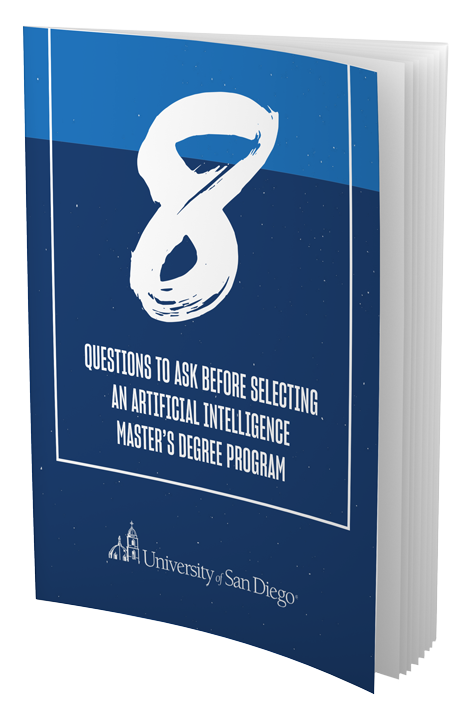The potential of using artificial intelligence in education to enhance learning, assist teachers and fuel more effective individualized learning is exciting, but also a bit daunting. To even have an intelligent conversation about AI in education, one must first push past imaginary science-fiction scenarios of computers and robots teaching our children, replacing teachers and reducing the human element from what is a fundamentally human activity.
One of the leading writers on the benefits of artificial intelligence in education, Matthew Lynch (“My Vision for the Future of Artificial Intelligence in Education”), is careful to explore the potential pitfalls along with the benefits, writing that “the use of AI in education is valuable in some ways, but we must be hyper-vigilant in monitoring its development and its overall role in our world.”
The ethical considerations are profound, as they are when it comes to using artificial intelligence in any type of setting. AI lacks a so-called “moral compass.” So, by one way of looking at it, AI programming is “as ethical as its developer,” according to TowardsDataScience, in an article about AI ethics that prescribes two important recommendations moving forward:
- We need to have ethics built into the idea of why a certain piece of technology, equipped with AI, is being developed.
- We need to monitor/check/police the outcomes of that specific piece of technology in order to fully understand its behavior and make sure that it’s not violating our (human) moral compass.
There is robust debate throughout the technology community and beyond about ethics in artificial intelligence and most university degree programs are integrating courses on AI ethics into their curriculum. There, now that we have identified the ethical elephant in the room, let’s talk about the exciting possibilities of AI in education.
The Potential Benefits of AI in Education
Ideally, writes Lynch in The EdAdvocate, “AI does not detract from classroom instruction but enhances it in many ways.” He summarizes five intriguing potential pluses of integrating AI in education:
Personalization: “It can be overwhelmingly difficult for one teacher to figure out how to meet the needs of every student in his/her classroom. … AI systems easily adapt to each student’s individual learning needs and can target instruction based on their strengths and weaknesses.”
Tutoring: AI systems can “gauge a student’s learning style and pre-existing knowledge to deliver customized support and instruction.”
Grading: Sure, AI can help grade exams using an answer key; but it can also “compile data about how students performed and even grade more abstract assessments such as essays.”
Feedback on course quality: For example, if many students are answering a question incorrectly, “AI can zero in on the specific information or concepts that students are missing, so educators can deliver targeted improvements in materials and methods.”
Meaningful and immediate feedback to students: Some students may be shy about taking risks or receiving critical feedback in the classroom, but “with AI, students can feel comfortable to make the mistakes necessary for learning and receive the feedback they need for improvement.”
Much of the potential envisioned for AI in education centers on reducing time spent by teachers on tedious tasks to free up time for more meaningful ones.
Automating administrative tasks is also one of five potential benefits spotlighted by Bernard Marr, an author, futurist and technology advisor who cites figures forecasting 47.5% growth from 2017-2021 in the use of artificial intelligence in education in the U.S.
In a video on the potential of AI in education, Marr explains why he sees AI having a “massive impact” in education — emphasizing that “AI is not a threat to teachers; it is not there to replace teachers,” but rather to deliver a better education to our children.” He envisions a future hybrid model that is designed to “get the best out of our artificially intelligent-enabled systems and our teachers.” Marr outlines the potential of AI to help our education provide enhanced:
- Differentiated and individualized learning
- Automation of administrative tasks
- Tutoring and support outside the classroom
- Universal access for all students
43 Examples of AI in Education
Inspired by a challenge from “an old school teacher who thinks that AI is ruining education,” Matthew Lynch reviews a wide range of topics in a piece titled “26 Ways That Artificial Intelligence Is Transforming Education For The Better.” For example:
Adaptive Learning: “Used to teach students basic and advanced skills by assessing their present skill level and creating a guided instructional experience that helps them become proficient.”
Assistive Technology: AI can help special needs students access a more equitable education, for example by “reading passages to a visually impaired student.”
Early Childhood Education: “AI is currently being used to power interactive games that teach children basic academic skills and more.”
Data and Learning Analytics: “AI is currently being used by teachers and education administrators to analyze and interpret data,” enabling them to make better-informed decisions.
Scheduling: Helping administrators to schedule courses and individuals to manage their daily, weekly, monthly or yearly schedules.
Facilities Management: AI is effective at “monitoring the status of power, Wi-Fi and water services; alerting the facilities management workers when problems arise.”
Overall School Management: AI is currently being used to manage entire schools, powering student records systems, transportation, IT, maintenance, scheduling, budgeting, etc.
Writing: Not only does Lynch assert that AI is already at work helping students improve their writing skills, he confesses, “I am currently using a grammar and usage app to help me write this article.”
Running down his list, Lynch also cites current uses of AI in education that include:
- Classroom/Behavior Management
- Lesson Planning
- Classroom Audio-Visual
- Parent-Teacher Communication
- Language Learning
- Test Prep
- Assessment
- Learning Management Systems
- Gamification for Enhanced Student Engagement
- Staff Scheduling and Substitute Management
- Professional Development
- Transportation
- Maintenance
- Finance
- Cybersecurity
- Safety and Security
Examples of how artificial intelligence is currently being used in higher education include:
- Plagiarism Detection
- Exam Integrity
- Chatbots for Enrollment and Retention
- Learning Management Systems
- Transcription of Faculty Lectures
- Enhanced Online Discussion Boards
- Analyzing Student Success Metrics
- Academic Research
- Connected Campuses
In terms of AI-infused specific technologies now being used in education, the list grows longer every day. Here are just a few:
- Thinkster Math: described by its creators as a “math tutoring program leverages human interaction and groundbreaking artificial intelligence to create personalized learning programs”
- Jill Watson: an AI-enabled virtual teaching assistant introduced by the Georgia Institute of Technology in 2016
- Brainly: a social media site for classroom questions
- Nuance: speech recognition software used by students and faculty; capable of transcribing up to 160 words per minute; especially helpful for students who struggle with writing or have accessibility needs
- Cognii: AI-based products, including a virtual learning assistant, for K-12 and higher education institutions, as well as corporate training organizations
- KidSense: AI educational solutions designed for children, including a voice-to-text tool with algorithms built to recognize the sometimes harder-to-translate speech of young learners
- Content Technologies: instructional design and content application solutions fueled by artificial intelligence research engines
As explained by CEO Dr. Scott Parfitt (see video), Content Technologies Inc. develops AI learning systems that are focused on “turning big data into information, and information into knowledge.”
“We send an engine out, it starts reading at light speed every article it can read. It’s learned its own material,” says Parfitt. The company’s education-focused solutions include:
- Palitt: built to help instructors easily create “your own custom lecture series, syllabus or textbook”
- Cram101: AI technology that can “turn any textbook into a smart study guide complete with chapter summaries, unlimited true-false and multiple choice practice tests and flashcards all drilled down to a specific textbook, ISBN number, author and chapter.”
- JustTheFacts101: intended to function as the AI equivalent of an old-fashioned yellow marker, instantly highlighting and generating book and chapter-specific summaries
AI in Education [Inclusion and Universal Access]
Bernard Marr explains that AI tools can enhance inclusion and universal access to education in a number of ways, including:
- Helping to “make global classrooms available to all, including those who speak different languages or who might have visual or hearing impairments”
- Creating access for “students who might not be able to attend school due to illness”
- Better serving “students who require learning at a different level or on a particular subject that isn’t available in their own school”
Overall, it is hoped that AI will ultimately help educators make continued progress in addressing the broad range of physical, cognitive, academic, social and emotional factors that can affect student learning and ensure that all students have equal opportunity in education, regardless of their social class, race, gender, sexuality, ethnic background or physical and mental disabilities.
AI in Education [Individualized Learning]
There is also considerable optimism around the idea that, as artificial intelligence becomes a more integral part of the classroom, teachers will be better equipped to offer an individualized learning experience for every student.
According to an article in The Atlantic, (“Artificial Intelligence Promises a Personalized Education for All”), artificial intelligence holds the potential to “enhance human teachers’ abilities to tailor lessons to each student without knocking their class schedule off track,” eliminating the need for educators to “teach to the middle,” as often happens when their students have a range of skill levels and learning abilities.
Rose Luckin, a professor of learning-centered design at University College London, is quoted as saying that, “The real power of artificial intelligence for education is in the way that we can use it to process vast amounts of data about learners, about teachers, about teaching and learning interactions.” Ultimately, AI can “help teachers understand their students more accurately, more effectively.”
The Future of AI in Education
Though there continues to be widespread debate over the pros and cons of deploying AI technology in the field of education, including the concerns about depersonalization and the ethical considerations cited above, there is an emerging consensus that the extraordinary range of current and future benefits will carry the day.
This report on Artificial Intelligence in Education was developed by the University of San Diego’s innovative, online Master of Science in Applied Artificial Intelligence program, an AI industry thought leader and education partner.




